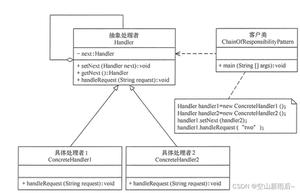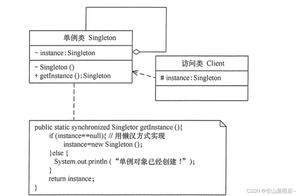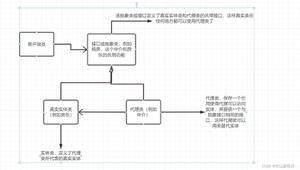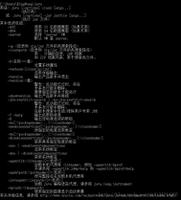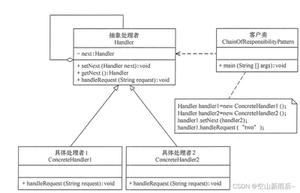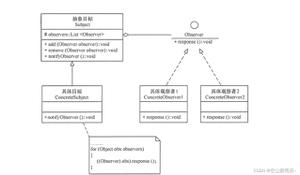【Java】我所知道设计模式之单例模式
前言需求
所谓类的单例设计模式,就是采取一定的方法保证在整个的软件系统中,对某个类只能存在一个对象实例, 并且该类只提供一个取得其对象实例的方法(静态方法)。
在出名的Hibernate框架中的SessionFactory,它充当数据存储源的代理,并负责创建 Session 对象。
SessionFactory 并不是轻量级的,一般情况下,一个项目通常只需要一个 SessionFactory 就够,这是就会使用到单例模式

一、饿汉式(静态常量)
步骤如下:
1.构造器私有化(防止new)
2.类的内部创建对象
3.对外暴露一个静态的方法
class Singleton {//1. 构造器私有化, 外部不能 new
private Singleton() {}
//2.本类内部创建对象实例
private final static Singleton instance = new Singleton();
//3. 提供一个公有的静态方法,返回实例对象
public static Singleton getInstance() { return instance;}
}
public static void main(String[] args) {//测试
Singleton instance = Singleton.getInstance();
Singleton instance2 = Singleton.getInstance();
System.out.println(instance == instance2); // true
System.out.println("instance.hashCode=" + instance.hashCode());
System.out.println("instance2.hashCode=" + instance2.hashCode());
}
运行结果如下:
true
instance.hashCode=366712642
instance2.hashCode=366712642
优缺点说明:
1.优点:这种写法比较简单,就是在类装载的时候就完成实例化。避免了线程同步问题。
2.缺点:在类装载的时候就完成实例化,没有达到 Lazy Loading 的效果。如果从始至终从未使用过这个实例,则会造成内存的浪费
3.这种方式基于 classloder 机制避免了多线程的同步问题,不过instance 在类装载时就实例化。
在单例模式中大多数都是调用 getInstance 方法,但是导致类装载的原因有很多种
因此不能确定有其他的方式(或者其他的静态方法)导致类装载,这时候初始化 instance 就没有达到 lazy loading 的效果
结论:这种单例模式可用,可能造成内存浪费
二.饿汉式(静态代码块)
步骤如下:
1.构造器私有化(防止new)
2.类的内部创建对象
3.对外暴露一个静态的方法
class Singleton {//1. 构造器私有化,外部不能new
private Singleton() {}
private static Singleton instance;
//2.在静态代码块中,创建单例对象
static {
instance = new Singleton();
}
//3. 提供一个公有的静态方法,返回实例对象
public static Singleton getInstance() { return instance;}
}
public static void main(String[] args) {//测试
Singleton instance = Singleton.getInstance();
Singleton instance2 = Singleton.getInstance();
System.out.println(instance == instance2); // true
System.out.println("instance.hashCode=" + instance.hashCode());
System.out.println("instance2.hashCode=" + instance2.hashCode());
}
运行结果如下:
true
instance.hashCode=366712642
instance2.hashCode=366712642
优缺点说明:
1.这种方式和上面的方式其实类似,只不过将类实例化的过程放在了静态代码块中。
也是在类装载的时候,就执行静态代码块中的代码,初始化类的实例。优缺点和上面是一样的
结论:这种单例模式可用,但是可能造成内存浪费
三、懒汉式(线程不安全)
步骤如下:
1.构造器私有化(防止new)
2.类的内部创建对象
3.对外暴露一个静态的方法
class Singleton {//1. 构造器私有化,外部不能new
private Singleton() {}
private static Singleton instance;
//2. 提供一个公有的静态方法,返回实例对象
//即提静态的方法,使用到的时候才会创建instance
public static Singleton getInstance() {
if(instance == null) {
instance = new Singleton();
}
return instance;
}
}
public static void main(String[] args) {//测试
Singleton instance = Singleton.getInstance();
Singleton instance2 = Singleton.getInstance();
System.out.println(instance == instance2); // true
System.out.println("instance.hashCode=" + instance.hashCode());
System.out.println("instance2.hashCode=" + instance2.hashCode());
}
运行结果如下:
true
instance.hashCode=366712642
instance2.hashCode=366712642
当第一个instance 调用进来时,满足if判断 创建对象
当第二个instance 调用进来时,不满足则直接返回对象
优缺点说明:
1.起到了 Lazy Loading 的效果,但是只能在单线程下使用。
2.如果在多线程下,一个线程进入了 if (singleton == null)判断语句块,还未来得及往下执行,另一个线程也通过了这个判断语句
这时便会产生多个实例。所以在多线程环境下不可使用这种方式
结论:在实际开发中,不要使用这种方式.
四、懒汉式(线程安全,同步方法)
步骤如下:
1.构造器私有化(防止new)
2.类的内部创建对象
3.对外暴露一个静态的方法
class Singleton {//1. 构造器私有化,外部不能new
private Singleton() {}
private static Singleton instance;
//2. 提供一个公有的静态方法,返回实例对象
public static synchronized Singleton getInstance() {
if(instance == null) {
instance = new Singleton();
}
return instance;
}
}
public static void main(String[] args) {//测试
Singleton instance = Singleton.getInstance();
Singleton instance2 = Singleton.getInstance();
System.out.println(instance == instance2); // true
System.out.println("instance.hashCode=" + instance.hashCode());
System.out.println("instance2.hashCode=" + instance2.hashCode());
}
运行结果如下:
true
instance.hashCode=366712642
instance2.hashCode=366712642
优缺点说明:
1.解决了线程安全问题
2.效率太低了,每个线程在想获得类的实例时候,执行 getInstance()方法都要进行同步。
而其实这个方法只执行一次实例化代码就够了,后面的想获得该类实例,直接 return 就行了。方法进行同步效率太低
结论:在实际开发中,不推荐使用这种方式
五、懒汉式(线程安全,同步代码块)
class Singleton {//1. 构造器私有化,外部不能new
private Singleton() {}
private static Singleton instance;
//2. 提供一个公有的静态方法,返回实例对象
public static Singleton getInstance() {
if(instance == null) {
synchronized(Singleton.class){
instance = new Singleton();
}
}
return instance;
}
}
优缺点说明:
1.这种方式,本意是想对第四种实现方式的改进
因为前面同步方法效率太低,改为同步产生实例化的的代码块。
2.但是这种同步并不能起到线程同步的作用。
跟第3种实现方式遇到的情形一致,假如一个线程进入if(singleton == null)判断语句块,还未来得及往下执行,另一个线程也通过了这个判断语句,这时便会产生多个实例
结论:在实际开发中,不要使用这种方式
六、双重检查
class Singleton {//1. 构造器私有化,外部不能new
private Singleton() {}
private static volatile Singleton instance;
//提供一个静态的公有方法,加入双重检查代码,解决线程安全问题, 同时解决懒加载问题
//同时保证了效率, 推荐使用
public static Singleton getInstance() {
if(instance == null) {
synchronized (Singleton.class) {
if(instance == null) {
instance = new Singleton();
}
}
}
return instance;
}
}
优缺点说明:
1.Double-Check概念是多线程开发中常使用到的。
如代码中所示,我们进行了两次 if (singleton == null)检查,这样就可以保证线程安全了。
2.这样,实例化代码只用执行一次,后面再次访问时,判断 if (singleton == null),直接 return 实例化对象,也避免的反复进行方法同步
3.线程安全、延迟加载、效率较高
结论:在实际开发中,推荐使用这种单例设计模式
为什么使用volatile这种方式就推荐呢?请看小编另一篇文章: volatile 的一连串轰炸问题
七、静态内部类
class Singleton {//构造器私有化
private Singleton() {}
//写一个静态内部类,该类中有一个静态属性 Singleton
private static class SingletonInstance {
private static final Singleton INSTANCE = new Singleton();
}
//提供一个静态的公有方法,直接返回 SingletonInstance.INSTANCE
public static Singleton getInstance() {
return SingletonInstance.INSTANCE;
}
}
优缺点说明:
1.这种方式采用了类装载的机制来保证初始化实例时只有一个线程。
2.静态内部类方式在 Singleton 类被装载时并不会立即实例化,而是在需要实例化时。
调用 getInstance 方法,才会装载 SingletonInstance 类,从而完成 Singleton 的实例化。
3.类的静态属性只会在第一次加载类的时候初始化,所以在这里,JVM 帮助我们保证了线程的安全性,在类进行初始化时,别的线程是无法进入的。
4.优点:避免了线程不安全,利用静态内部类特点实现延迟加载,效率高
结论:推荐使用.
八、枚举
enum Singleton {INSTANCE; //属性
public void sayOK() {
System.out.println("ok~");
}
}
优缺点说明:
1.这借助 JDK1.5 中添加的枚举来实现单例模式。不仅能避免多线程同步问题,而且还能防止反序列化重新创建新的对象。
2.这种方式是 Effective Java 作者 Josh Bloch 提倡的方式
结论:推荐使用
九、单例模式源码分析
其实在我们 JDK 中,java.lang.Runtime 就是经典的单例模式(饿汉式)
我们可以一起来分析看看
public class Runtime {//2.类的内部创建对象
private static Runtime currentRuntime = new Runtime();
//3.对外暴露一个静态方法
public static Runtime getRuntime() {
return currentRuntime;
}
//1.构造器私有化
private Runtime() {}
}
十、单例模式的注意事项和细节说明
一、单例模式保证了 系统内存中该类只存在一个对象,节省了系统资源,对于一些需要频繁创建销毁的对象,使用单例模式可以提高系统性能
二、当想实例化一个单例类的时候,必须要记住使用相应的获取对象的方法,而不是使用 new
三、单例模式使用的场景:
1.需要频繁的进行创建和销毁的对象、创建对象时耗时过多或耗费资源过多(即:重量级对象)
2.经常用到的对象、工具类对象、频繁访问数据库或文件的对象(比如数据源、session 工厂等)`
参考文献
尚硅谷:设计模式(韩顺平老师):单例模式
Refactoring.Guru:《深入设计模式》
以上是 【Java】我所知道设计模式之单例模式 的全部内容, 来源链接: utcz.com/a/92115.html

